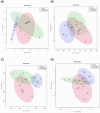Deciphering metabolomics and lipidomics landscape in zebrafish hypertrophic cardiomyopathy model
- PMID: 39300306
- PMCID: PMC11413214
- DOI: 10.1038/s41598-024-72863-5
Deciphering metabolomics and lipidomics landscape in zebrafish hypertrophic cardiomyopathy model
Abstract
To elucidate the lipidomic and metabolomic alterations associated with hypertrophic cardiomyopathy (HCM) pathogenesis, we utilized cmybpc3-/- zebrafish model. Fatty acid profiling revealed variability of 10 fatty acids profiles, with heterozygous (HT) and homozygous (HM) groups exhibiting distinct patterns. Hierarchical cluster analysis and multivariate analyses demonstrated a clear separation of HM from HT and control (CO) groups related to cardiac remodeling. Lipidomic profiling identified 257 annotated lipids, with two significantly dysregulated between CO and HT, and 59 between HM and CO. Acylcarnitines and phosphatidylcholines were identified as key contributors to group differentiation, suggesting a shift in energy source. Untargeted metabolomics revealed 110 and 53 significantly dysregulated metabolites. Pathway enrichment analysis highlighted perturbations in multiple metabolic pathways in the HM group, including nicotinate, nicotinamide, purine, glyoxylate, dicarboxylate, glycerophospholipid, pyrimidine, and amino acid metabolism. Our study provides comprehensive insights into the lipidomic and metabolomic unique signatures associated with cmybpc3-/- induced HCM in zebrafish. The identified biomarkers and dysregulated pathways shed light on the metabolic perturbations underlying HCM pathology, offering potential targets for further investigation and potential new therapeutic interventions.
Keywords: Hypertrophic cardiomyopathy; Lipidomics; MYBPC3; Metabolomics; Zebrafish.
© 2024. The Author(s).
Conflict of interest statement
The authors declare no competing interests.
Figures





References
-
- Maron, B. J. et al. Diagnosis and evaluation of hypertrophic cardiomyopathy: JACC state-of-the-art review. J. Am. Coll. Cardiol.79, 372–389. 10.1016/j.jacc.2021.12.002 (2022). - PubMed
MeSH terms
Substances
LinkOut - more resources
Full Text Sources
Molecular Biology Databases

